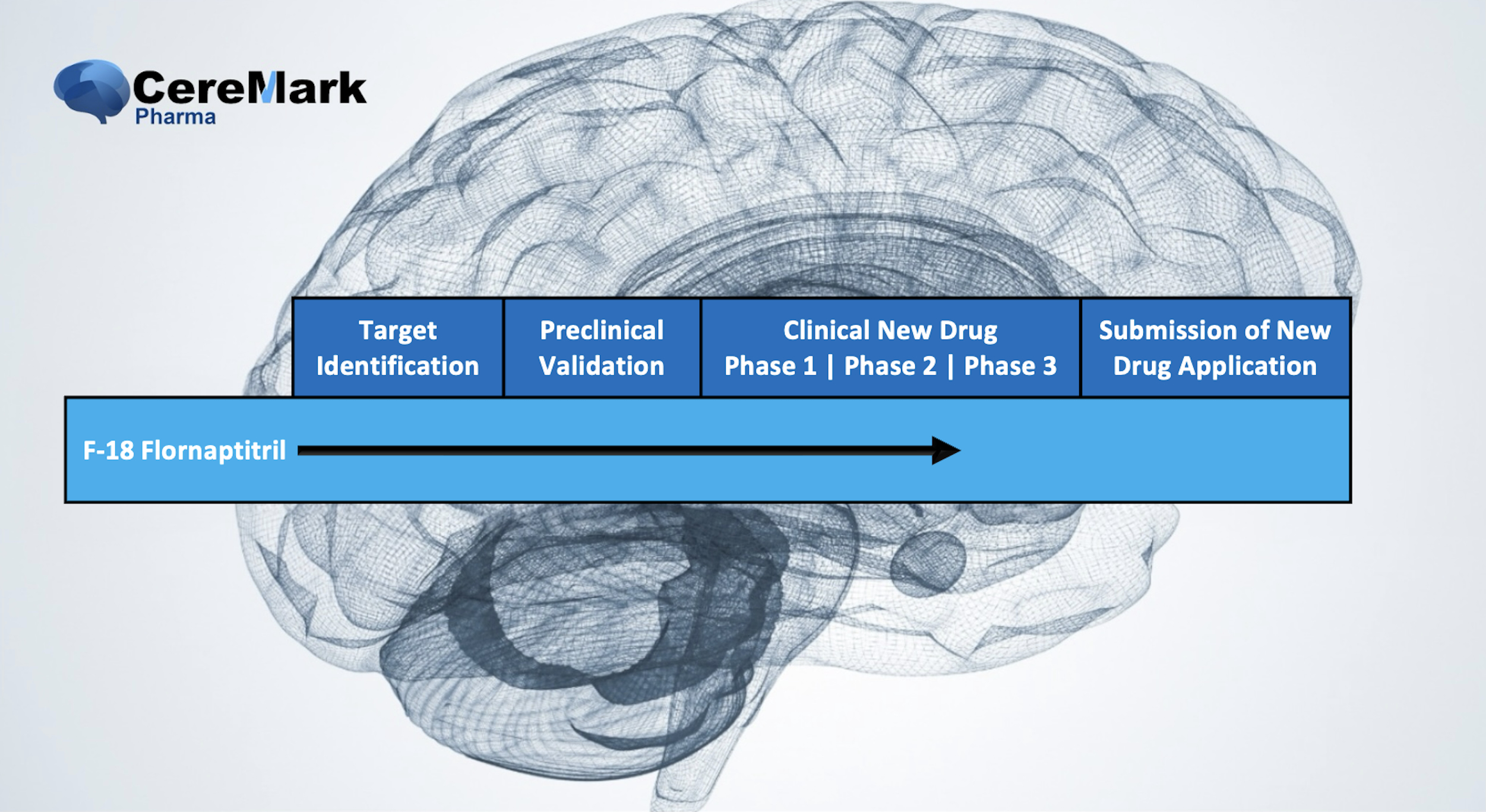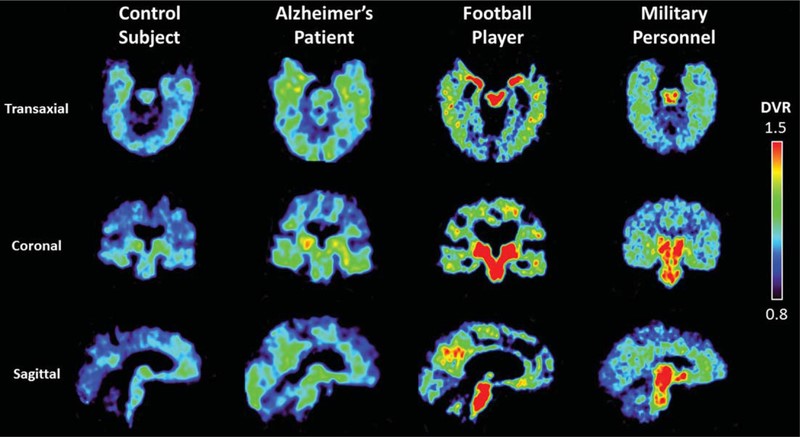Visualizing Neurodegenerative Disease Development in Living Brains
Alzheimer’s disease (AD) and Chronic Traumatic Encephalopathy (CTE) may present with the same early symptoms of memory loss, confusion and personality changes, and both diseases are associated with key pathological neuroproteins, beta-amyloid plaque and tau aggregates. However, the neurological pathology of AD and CTE differs in that the distribution and uptake of these two proteins occur at different disease stages in different brain regions and densities. AD is primarily associated with the accumulation of beta-amyloid protein plaques in the brain early on, followed by tau aggregates as neurological deficit worsens. Conversely, CTE typically presents as a buildup of tau protein deposits in the early stages of disease development. Understanding the regional distribution and density of beta-amyloid plaques and tau protein aggregates in brain regions is critical to understanding neurodegeneration progression and effective patient management.
Our Timeline

Advancing precision imaging in the assessment of brain pathology related to cognitive impairment caused by AD and CTE
Bringing More Precision to Disease Management
Research has shown that the ability to image both beta-amyloid plaques and tau protein aggregates in a single PET could provide a higher degree of precision in understanding disease state progression as well as serving as a potential tool for quantity shifts in beta-amyloid plaque brain burden as a measure of efficacy with AD therapy. Providing quantification, localization, anatomical uptake density and progression analysis of these proteins could lead to greater confidence in the decision-making process of how best to manage these life-debilitating diseases
Why F-18 Flornaptitril’s Capabilities Are Critical
- Mild cognitive impairment likely signals early disease, and knowing the type is critical.
- Alzheimer’s disease and CTE can present similarly in early stages, each requiring different management.
- Appropriate therapy requires precise diagnosis and serial follow-up scans to gauge therapy.
- Currently, autopsy is the only confirmed methodology for determining CTE.
- Alzheimer’s and CTE are associated with two key pathological neuroproteins (tau and beta-amyloid) at different stages in different brain regions.
- To manage these life-debilitating diseases, simultaneous imaging (in the same PET image) of tau and beta-amyloid proteins is necessary for quantification, brain region localization, anatomical uptake density and progression analysis.
- No currently available technology provides simultaneous imaging of proteins (in the same single PET image).
F-18 Flornaptitril is a new investigational radiopharmaceutical used in conjunction with Positron Emission Tomography (PET) and has been safely tested in research trials involving several hundreds of subjects. CereMark Pharma plans to innovate the pivotal Phase 3 clinical trial of F-18 Flornaptitril this year.
Building a Pipeline Focused on Neurodegenerative Diseases
Investigational research with F-18 Flornaptitril in humans, and collaborative tissue samples taken at autopsy in a subject who underwent PET imaging with F-18 Flornaptitril, showed that F-18 Flornaptitril is taken up by tau and beta-amyloid proteins. Both are present in forms of neurodegenerative diseases, including AD and CTE associated with traumatic brain injuries (TBI). Investigational New Drug (IND) studies with F-18 Flornaptitril have been performed in subjects with AD and suspected CTE, including concussive and percussive brain injuries.

PET images of subject brains obtained with F-18 Flornaptitril (fka, FDDNP)
Pictured: F-18 Flornaptitril images through mid-brain in actual humans showing uptake in different brain regions in healthy/normal subjects and those with pathology of AD and patients with histories of brain trauma as either concussive (NFL player) or percussive injuries (military veteran).
Note: the changing coloration in images (green to yellow to red) signals relatively higher uptake of F-18 Flornaptitril in respective brain regions.
Reprinted from J Alzheimers Dis 65(1), Chen ST, et al., “FDDNP-PET Tau Brain Protein Binding Patterns in Military Personnel with Suspected Chronic Traumatic Encephalopathy”, 79-88, Copyright (2018), with permission from IOS Press.
Research Publications Involving CereMark Personnel
Neurordegenerative Diseases, PET Imaging, FDDNP, And Neurobiology
Omalu BI, et. al. Chronic traumatic encephalopathy in a National Football League player. Neurosurgery 57(1):128-134, discussion 128-134,2005.
Omalu BI, et al. Chronic traumatic encephalopathy in a national football league player: Part II. Neurosurgery 59(5):1086-1092, discussion 1092-1093, 2006.
Omalu BI, et al. Chronic traumatic encephalopathy in an Iraqi war veteran with posttraumatic stress disorder who committed suicide, Neurosurg Focus 31(5): E3,10.3171/2011.9.FOCUS11178.
Omalu B, Bailes J, Hammers J, Fitzsimmons RP: Chronic traumatic encephalopathy, suicide and parasuicides in professional American athletes: the role of the forensic pathologist. Am J Forensic Med Pathol. Jun;31(2):130-2, 2010.
Omalu B, Hamilton RL, Kamboh MI, DeKosky ST, Bailes J: Chronic traumatic encephalopathy in a National Football League player: case report and emerging medicolegal practice questions. J Forensic Nurs. 6:40-46, 2010.
Omalu BI, Fitzsimmons RP, Hammers J, Bailes J. Chronic traumatic encephalopathy in a professional American wrestler. J Forensic Nurs. Fall;6(3):130-6, 2010.
Omalu B, Bailes J, Hamilton R, Kamboh I, Hammers J, Case M, Fitzsimmons R. Emerging histomorphologic phenotypes of chronic traumatic encephalopathy (CTE) in American athletes. Neurosurgery. 69: 173-183, 2011.
Omalu B, Hammers JL, Bailes J, Hamilton RL, Kamboh MI, Webster G, Fitzsimmons RP. Chronic traumatic encephalopathy in an Iraqi war veteran with posttraumatic stress disorder who committed suicide. Neurosurg Focus. Nov;31(5): E3, 2011. Doi 10.3171/2011.9. FOCUS11178.
Shin J, Kepe V, Barrio JR, Small GW: The merits of FDDNP-PET imaging in Alzheimer’s Disease: J Alzheimers Dis 26(3):135-45, 2011.
Petric A, Johnson SA, Pham HV, Li Y, Ceh S, Golobic A, Agdeppa ED, Timbol G, Liu J, Keum G, Satyamurthy N, Kepe V, Houk KN, Barrio JR: Dicyanovinylnaphthalenes for neuroimaging of amyloids and relationships of electronic structures and geometries to binding affinities. PNAS 109 (41) 16492-16497, 2012.
Tent E, Kepe V, Frautschy SA, Liu J, Satyamurthy N, Yang F, Chen PP, Cole GB, Jones MR, Huang SC, Flood DG, Trusko SP, Small GW, Cole GM, Barrio JR: [F-18]FDDNP microPET imaging correlates with brain AB burden in a transgenic rat model of Alzheimer disease: Effects of aging, in vivo blockage, and anti-AB antibody treatment. Int J Alzheimers Dis 2012.
Turner RC, Lucke-Wold B, Robson MJ, Omalu BI, Petraglia AL, Bailes JE: Repetitive traumatic brain injury and development of chronic traumatic encephalopathy: a potential role for biomarkers in diagnosis, prognosis, and treatment? Front Neurol 3:186, 2012.
Wilks MQ, Protas H, Wardak M, Kepe V, Small GW, Barrio JR, Huang SC: Automated VOI analysis in FDDNP PET using structural warping: Validation throough classification of Alzheimer’s disease patients. Int J Alzheimers Dis.109(41) 512069, 2012.
Small GW, Kepe V, Siddarth P, Ercoli LM, Merrill DA, Donogue N, Bookheimer SY, Martinez J, Omalu B, Bailes JE, Barrio JR: Pet scanning of brain tau in retired national football league players: Preliminary Findings. Am J Geriatr Psychiatry 21: 138-144, 2013.
Lucke-Wold B, Turner R, Bailes, J, et al: Linking traumatic brain injury to chronic traumatic encephalopathy: Identification of potential mechanisms leading to neurofibrillary tangle development. J Neurotrauma. 31(13):1129-38, 2014.
Stone JL, Patel V, Bailes JE: Sir Hugh Cairns and World War II British advances in: Head Injury management, diffuse brain injury and concussion – An Oxford Tale. J Neurosurg, 19:1-14, 2016.
Stone, JL, Bailes JE, Patel V: The history of neurosurgical treatment of sports concussion. Neurosurgery October, 75: S3-S23, 2014.
Bailes JE, Turner R, Locke-Wold B, Patel V, Lee J. Chronic traumatic encephalopathy: Is it real? The relationship between neurotrauma and neurodegeneration. Neurosurgery Suppl 1: 15-24, 2015.
Ryan C, Turner B, Lucke-Wold P, Lee, J, Bailes J, Petraglia A: Modeling chronic traumatic encephalopathy: the way forward for future discovery. Front Neurol, 6:223-230, 2015.
Barrio JR, Small GW, Wong K-P, Huang S-C, Liu J, Merrill DA, Giza CC, Fitzsimmons RP, Omalu B, Bailes J, Kepe V: In vivo characterization of chronic traumatic encephalopathy using [F-18] FDDNP PET brain imaging. Proc Natl Acad Sci 112: E2039-47, 2015.
Bailes J, Bravo S, Breiter H, Kaufman D, Lu Z, Molfese D, Perrish T, Slobounov S, Talavage T, Zhu D. A call to arms: the need to create an inter-institutional concussion neuroimaging consortium to discover clinically relevant diagnostic biomarkers and develop evidence-based interventions to facilitate recovery. Dev Neuropsychol. 40(2):59-62, 2015.
Lucke-Wold BP, Naser ZJ, Logsdon AF, Turner RC, Smith KE, Robson MJ, Bailes JE, Lee JM, Rosen CL, Huber JD. Amelioration of nicotinamide adenine dinucleotide phosphate-oxidase mediated stress reduces cell death after blast-induced traumatic brain injury. Transl Res Dec;166(6):509-528.e1, 2015.
Bailes JE, Patel V, Farhat H, Sindelar B, Stone J. Football fatalities: the first-impact syndrome. J Neurosurg Pediatr.19:116-121. 2016.
Ban VS, Madden CJ, Bailes JE, Batjer HH, Lonser RR: The science and questions surrounding chronic traumatic encephalopathy. Neurosurg Focus 40(4):E15, 2016.
Turner RC, Lucke-Wold BP, Bailes JE, Lee JM, Robson MJ: Alzheimer’s disease and chronic traumatic encephalopathy: Distinct but possibly overlapping disease entities. Brain Inj. 11:1-14, 2016.
Lucke-Wold BP, Logsdon AF, Maroon JC, Bailes JE, et al. Supplements, nutrition, and alternative therapies for the treatment of traumatic brain injury. Nutr Neurosci doi 10.1080/1028415X.2016.1236174.
Manley G, Gardner AJ, Schneider KJ, Bailes J, et al: A systematic review of potential long-term effects of sport-related concussion. Br J Sports Med 51: 969-977, 2017.
Omalu B, Small GW, Barrio J, Bailes J, Lee J. Post-mortem autopsy-confirmation of ante-mortem {F-18} FDDNP-PET scans in a football player with chronic traumatic encephalopathy. Neurosurgery 82:237-246, 2018.
Chen ST, Siddarth P, Merrill DA, Martinez J, Miller K, Ercoli L, Emerson ND, Jie L, Koon-Pong W, Satyamurthy N, Giza C, Sung-Cheng H, Fitzsimmons RP, Bailes J, Omalu B, Barrio JR, Small GW. FDDNP-PET Tau brain binding patterns in military personnel with suspected chronic traumatic encephalopathy. J Alzheimer’s Dis 65: 79-88, 2018.
